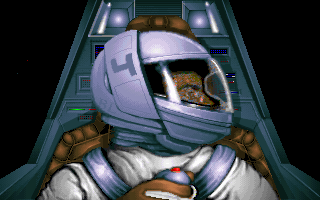Retro Replay Review
Gameplay
XF5700 Mantis Experimental Fighter delivers a richly detailed mission-based experience that demands both tactical thinking and deft piloting. Players step into the cockpit of the advanced XF5700 Mantis starfighter, relying on Newtonian physics to weave graceful arcs and precise maneuvers through the void of space. The controls strike a balance between accessibility and depth—newcomers can grasp the basic flight mechanics quickly, while veterans of space sims will appreciate mastering the inertia-driven drift and thrust-based vectoring.
(HEY YOU!! We hope you enjoy! We try not to run ads. So basically, this is a very expensive hobby running this site. Please consider joining us for updates, forums, and more. Network w/ us to make some cash or friends while retro gaming, and you can win some free retro games for posting. Okay, carry on 👍)
The ninety missions on offer span a diverse range of objectives, from classic dogfights against waves of insectoid invaders to high-stakes escort and defense scenarios. Each mission tends to blend offensive strikes—targeting alien capital ships or shielding civilian convoys—with careful resource management, as energy reserves and munitions must be monitored throughout the campaign. Wingmen AI behaviour is solid: they will respond to commands, break away to intercept targets, and call for backup, lending an authentic feel of squad-based warfare in deep space.
One of the standout features is the experimental weapon loadout system. As the pilot “Viper,” you unlock new variants of plasma cannons, guided missiles, and experimental railguns. Experimenting with different configurations encourages replayability, as certain loadouts prove more effective in specific mission scenarios or against particular alien vessel classes. The sense of progression as you upgrade and customize the XF5700 Mantis keeps the gameplay loop engaging over the title’s substantial runtime.
Graphics
For its era, XF5700 Mantis offers impressive graphical fidelity, rendered in crisp 3D polygons with detailed spacecraft models and sprawling starfields. The cockpit view is richly textured, with glowing instrument panels and responsive gauges that update in real time as damage accumulates or shields deplete. Exterior camera views showcase the sleek, mantis-inspired silhouette of the starfighter, complete with elegant swept-back wings and glowing engine thrusters.
Particle effects for lasers, missile trails, and explosions still hold up, delivering satisfying bursts of light against the velvet backdrop of space. The game’s lighting engine bathes each skirmish in stark contrasts—sunlight glinting off armor plating, shadowy nebulas providing a haunting backdrop, and the sudden flare of a plasma blast illuminating enemy hulls. Environmental hazards such as asteroid fields and debris clouds not only add challenge but create dynamic lighting opportunities that heighten immersion.
While terrain-free combat confines you to open space, mission designers make clever use of waypoints, jump-gate sequences, and scripted set-pieces to vary the visual experience. Interstellar gateways pulse with energy, alien motherships loom massive against distant stars, and catastrophic chain reactions of exploding capital ships create unforgettable spectacles. The palette remains strategically restrained—dark blues, blacks, and metallic grays—so weapon fire and explosion effects always stand out in sharp relief.
Story
XF5700 Mantis picks up the narrative from its predecessor Warhead, thrusting players into a universe under siege. The insect-like Sirians, endowed with a collective hive mind and telepathic abilities, have decimated their homeworld and now seek Earth as their new breeding ground. This high-stakes premise fuels a campaign steeped in urgency: you are Viper, Earth’s last line of defense, flying the experimental Mantis prototype to halt the verminous horde.
The plot unfolds through mission briefings, in-flight radio chatter, and occasional cutscenes that reveal the Sirians’ secret operations. Dialogue between Viper and Fist of Earth command injects personality and tension—friends lost in battle, daring strategic gambits, and the moral weight of facing an enemy that treats sapient life merely as hosts for its eggs. Though the story sticks closely to wartime tropes, the alien collective mind concept and the evolving threat level keep the narrative engaging across nearly a hundred missions.
Character development is subtle but effective: Viper’s steady professionalism contrasts with the raw fear and determination of ground forces, while occasional flashbacks to Siria hint at the Sirians’ tragic origins. The game avoids melodrama, instead letting the scale of interstellar conflict and the desperation of Earth’s defense speak for themselves. By the finale, you feel a genuine sense of accomplishment—and relief—that the final round of decisive engagements has been won.
Overall Experience
XF5700 Mantis Experimental Fighter excels at delivering a comprehensive space combat simulation that remains engaging from start to finish. The breadth of mission types, the nuanced Newtonian flight model, and the deep weapon customization combine to create a gameplay loop that rewards skill, strategy, and perseverance. Even after dozens of sorties, the game finds ways to introduce fresh challenges and escalating threats.
While the graphics and cockpit instrumentation evoke a classic 1990s aesthetic, they retain a timeless appeal that complements the game’s methodical pace. Players willing to embrace careful maneuvering and planning will find a satisfying contrast to more arcade-style shooters. The storytelling, though not revolutionary, provides a cohesive backdrop that elevates routine mission objectives into a broader fight for humanity’s survival.
In sum, XF5700 Mantis is a must-play for fans of space sims seeking depth, longevity, and a compelling war narrative. Its combination of realistic physics, varied missions, and memorable set-pieces ensures that the starfighter cockpit remains an enthralling command center throughout your fight against the Siran invasion. Whether you’re patrolling the outer moons or diving into the heart of enemy formations, the Mantis delivers a consistently rewarding experience.
 Retro Replay Retro Replay gaming reviews, news, emulation, geek stuff and more!
Retro Replay Retro Replay gaming reviews, news, emulation, geek stuff and more!









Reviews
There are no reviews yet.